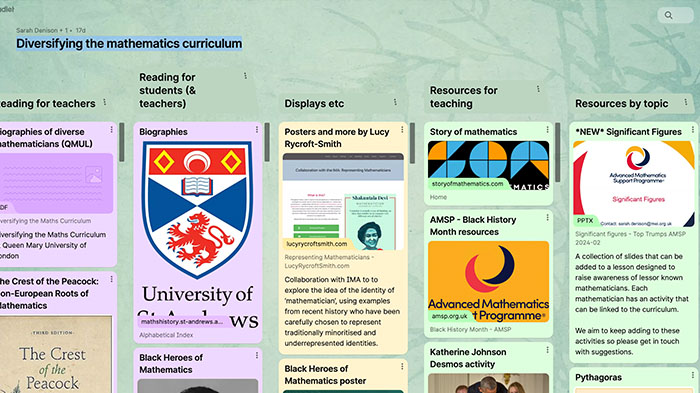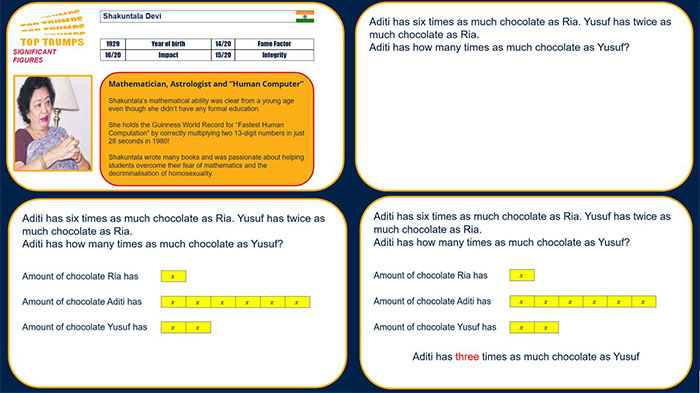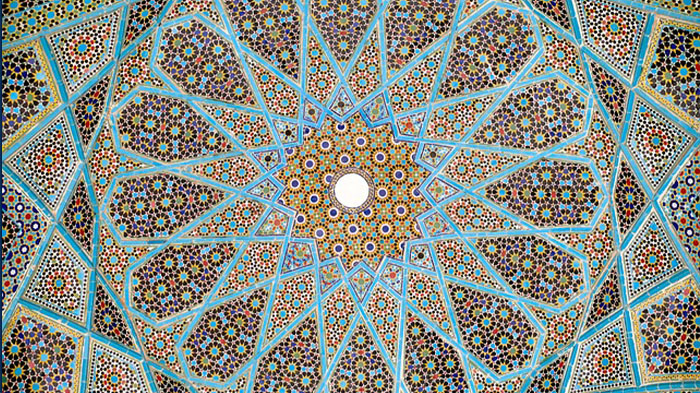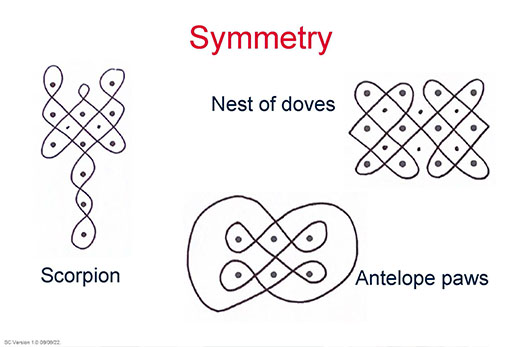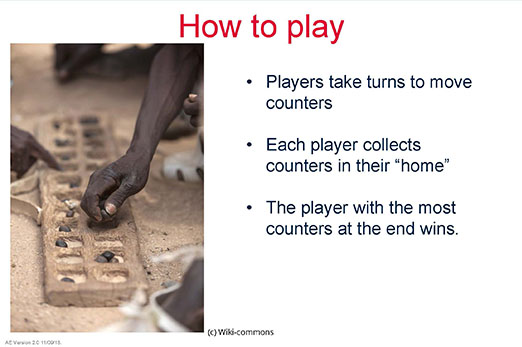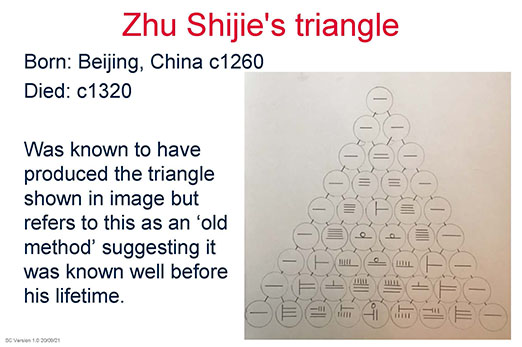Diversifying the curriculum to represent the students you teach, the population of the UK, and the rich global heritage of maths is a crucial part of being a teacher. Mathematics is a discipline which has developed over centuries and across all peoples and cultures. Too often in our specification-driven teaching, it is easy to miss the rich history behind some of the key ideas we use in school mathematics.
Here at the AMSP, we understand that you may lack the time to develop a diverse curriculum. Below, we explore why this is important and provide resources that you can embed into the curriculum.
Resources available
We have created a range of resources designed for teachers to use in their classrooms. They are also helpful for department heads or Key Stage leads when reflecting on the curriculum. They can also help you achieve your Gatsby Benchmarks:
Benchmark 7: Encounters with Further and Higher Education
Benchmark 4: Linking curriculum to careers
Diversifying the Curriculum
This comprehensive Padlet links to resources that can be embedded in the curriculum.
Significant figures (KS3, KS4 and KS5)
Raise awareness of lesser-known mathematicians and to uncover the sometimes murky history of mathematicians with a short activity which directly links their work to the Key Stage 3 or 4 Curriculum.
Regular beauty: Islamic designs (11-16)
Introduce your students to the idea of constructing Islamic geometric designs and how such designs are historically relevant and used in modern designs.
Regular beauty: Sona drawings (11-16)
A classroom resource exploring the geometrical patterns created by the Cokwe people of Angola.
Ibn Sina’s two rules of summation (11-16)
Illustrate some interesting results from number arrays described by the Persian mathematician Ibn Sina approximately 1000 years ago.
Whose triangle? (11-16)
Demonstrate the many interesting patterns involved in the array of numbers we usually refer to as ‘Pascal’s triangle.
Where did Pythagoras’ Theorem originate (11-16)
Apply angle facts, triangle congruence, similarity and properties of quadrilaterals to conjecture and derive results about angles and sides.
Easy as 1, 2, 3…(KS3)
Explore how different counting systems have developed around the world.
Further resources
“Why do Afro-Caribbean pupils underachieve in education?” is a useful article from in the Chalk Dust Magazine Archive of Black Mathematician Month.
The UK Government Ethnicity Facts and Figures website includes data on school pupil results at 5-7, 7-11, 11-16 and 16-18, as well as universities and where people go after education.
UCAS 2020 Cycle Applications Data provides useful online tools to analyse university entry data by many variables, including ethnicity.
Nightingale (The Journal of the Data Visualisation Society) published “W. E. B. Du Bois’ staggering Data Visualizations are as powerful today as they were in 1900” which looks at the statistical charts produced by an all-black team of mathematicians just 37 years after the end of slavery in the US.
Why is diversifying the curriculum important?
Diversifying the curriculum is important because it brings in perspectives from historically marginalised people. In maths, this means including mathematicians whose contributions have not previously been shared due to historical prejudices and discrimination. However, this does not mean excluding the great work of the historically dominant mathematicians; instead, it means expanding the curriculum to be inclusive to all those who have contributed to mathematics. Broadening the curriculum can enrich students’ understanding by incorporating global sources of knowledge and allow students to feel connected to their cultural traditions.
By including figures from all backgrounds, we can ensure that more students are represented in the mathematics they learn. This can help give students a sense of belonging in the world of maths.
Why should you bring this thinking into your classrooms?
It has been recognised that diversifying the curriculum has an important impact on young people’s relationship with maths. The APPG on Diversity and Inclusion in STEM inquiry said:
“STEM education that is more relevant to the lives of all young people”
The report implies that steps should be taken to ensure that all teaching and learning approaches are broad and inclusive in the knowledge and practices they represent and do not reproduce stereotypical ideas of who does STEM.
Click here for the full report: APPG on Diversity and Inclusion in STEM – Inquiry on Equity in STEM education.
By diversifying the curriculum, it can instil a feeling of belonging in mathematics for students who otherwise feel left out. Introducing role models students can see themselves in can lead to students choosing to continue to post-16 maths. Students need to be able to see themselves as mathematicians and mathematicians as more than just academics. Recreational mathematicians are also valuable to highlight that students don’t have to be the best at maths to contribute to the field.
Key aims for diversifying the curriculum
Equity and Inclusion: Diversifying the curriculum helps promote equity in education by ensuring that all students, regardless of their background, have access to a maths education that is relevant and inclusive. This is essential for reducing disparities in educational outcomes.
Representation: Including diverse mathematicians, historical perspectives, and mathematical contributions from various cultural and social backgrounds helps students see themselves reflected in the subject.
Motivation and Engagement: A diverse curriculum can make maths more engaging and interesting for a broader range of students. When students see mathematics’ real-world applications and relevance to various fields, they are more likely to be motivated to learn.
Global Perspective: In an increasingly interconnected world, understanding the mathematical contributions of various cultures and regions is essential. A diverse curriculum can help students appreciate the global nature of mathematics.
Addressing Stereotypes and Biases: Maths education can sometimes perpetuate stereotypes and biases. Diversifying the curriculum and pedagogy can help challenge and counteract these biases, making maths more accessible to all.
